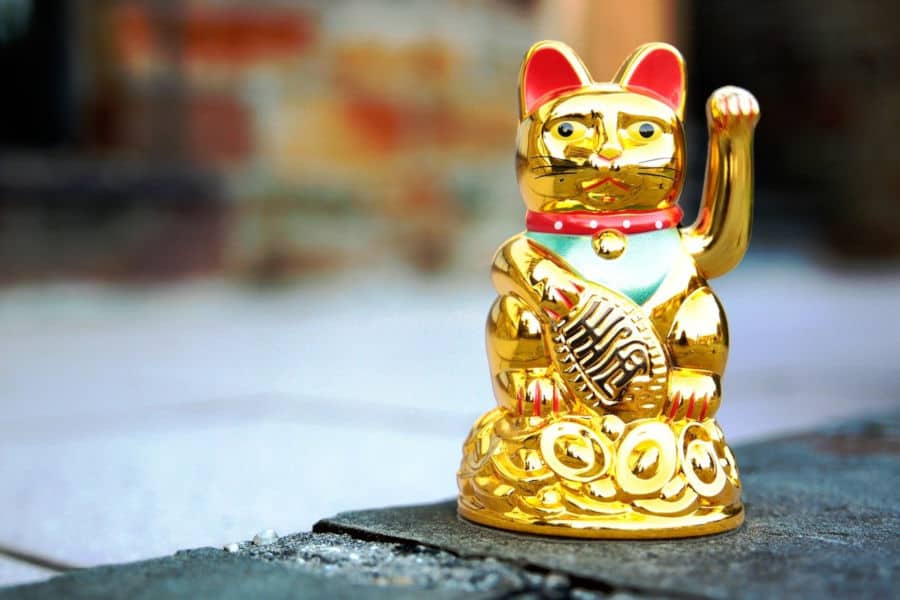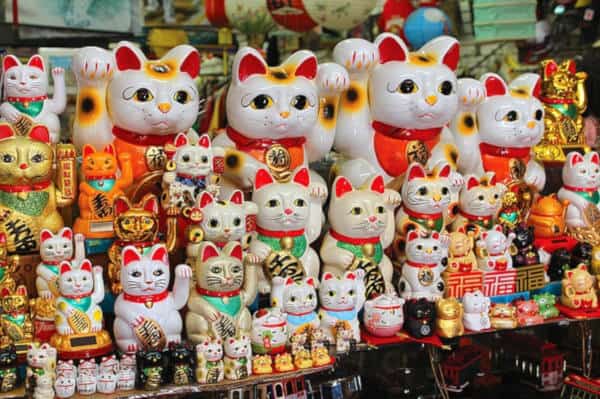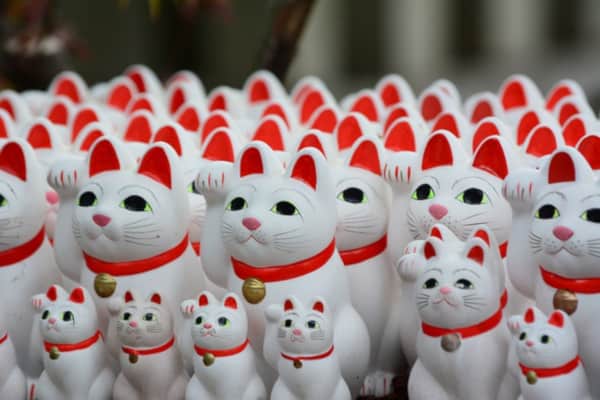
If you’ve ever visited a Japanese restaurant, Chinese store, or any other Eastern Asian businesses, you might have noticed a cat figurine with a raised paw placed in the doorway or placed on the cash register.
This cat figurine, however, is not merely a cute-looking decoration but is also considered a charm in the Japanese culture (and other Eastern Asian cultures) for good fortune and prosperity. Behold, the Maneki Neko.
What Is The Maneki Neko?
The Maneki Neko (招き猫) is a traditional Japanese figurine, and the Japanese phrase “Maneki Neko” can be literally translated to “beckoning cat”. However, it is also often called lucky cat, welcoming cat, money cat, or fortune cat in the English language.
Although it is a Japanese traditional idol, it is also extremely popular in Chinese culture and other countries where there are Chinese and Japanese descents. In Chinese, it is called zhāocáimāo (招财猫) which is translated to mean “lucky cat”
Some Maneki Neko figurines are static and the raised paws are designed to appear ready to move, while there are also some that feature a moving arm making the “beckoning” movement. In the case of moving statues, they can be hard-wired or battery powered.
In modern times, the Maneki Neko is typically made of ceramic, plastic, or sometimes metal materials, and often colored black, white, or gold. We might also find the Maneki Neko in other forms than statues like keychains, air fresheners, pots, piggy banks, and other forms.
Check out some “Lucky Fortune Cat” designs – Opens in new tab.
Maneki Neko Origin and History
There are actually several versions of the Maneki Neko’s origin. The most popular (and believable), is the one about Gotokuji Temple.
The Gotokuji temple is located in Setagaya-Ku, Tokyo, and during the early 1600s (when Tokyo was called Edo), the temple was in a terrible financial and physical state. There are, however, at least two popular versions of this story:
On the first, a weary traveler was passing this temple, and as he passed, a cat sat outside and beckoned this traveler to follow. Curious and weary, this man then followed the cat inside the temple. Yet, suddenly just after he entered the temple, a large thunderstorm came.
The traveler was so grateful to the cat for bringing him shelter from the storm and then purchased the temple to be his own. This is when the man named the temple Gotokuji.
Related reading: “Top 5 Famous Chinese Temples You Must Visit“
Another version involves a famous samurai lord named Naotaka Ii, who decided to take a break under a big tree near this temple. Suddenly, a thunderstorm came but this samurai saw a cat waving to him as if calling him to the temple.
Curious, he left the tree and headed inside the temple to look at the strange cat, and at the same time, a lightning bolt destroyed the tree he just took a break under. Naotaka was so grateful, so he donated a large sum of money to the temple and repaired to become more spacious.
It is believed that this cat, named Tama, was buried in the temple’s graveyard for the cats and the first Maneki Neko statue was made to commemorate Tama.
Another less popular but interesting story is about a poor store owner who fed a starving stray cat although he was actually very poor. This cat was very thankful and was sitting in front of the store to beckon customers, turning this otherwise humble store into a very busy one as a reward for the charitable owner. This was how the Maneki Neko became the symbol of success and financial luck for business owners.
There is also a Chinese version of the origin. According to Chinese legend, there is a cat goddess named Li Shou, who was a former caretaker of earth before men filled and ruled the earth.
Li Shou was worshipped as a minor goddess by fishermen and farmers in China and was believed to protect crops from vermin and for safety in Sea. As time goes, however, the real goddess was forgotten but the tradition of venerating the cat for luck and protection remains.
Related reading: “Chinese Good Luck Charms To Bring Good Fortune” –Opens in new tab

Maneki Neko: Colors and Their Meanings
Traditionally, Maneki Neko was colored white, but over the years we now have a wide range of color variations and there are also Maneki Neko figurines with unique finishes like shiny gold.
The different colors of the Maneki Neko figurines are influenced by Feng Shui. White, for example, symbolizes good fortune and overall good luck while gold symbolizes money and wealth. Black Maneki Neko figurines are believed to ward off evil, while red is for wealth and pink is for romance. Although less popular, there are also green Maneki Neko figurines that are believed to bring good health.
Businesses often place a Maneki Neko with a specific color according to the niche. For example, it’s not uncommon to see pink Maneki Neko in Chinese bridals, and you’ll often see gold or white Maneki Neko statues in restaurants.
Left, Right, or Both Paws
As mentioned, the Maneki Neko typically has one paw up making a beckoning gesture that is believed to attract good fortune.
However, there are actually different believes concerning the “effect” of what each paw will bring. The common tradition is that left paw raised brings in customers so you’ll see it in businesses that rely on traffic like restaurants, shopping malls, and so on. On the other hand, the right paw is believed to bring wealth, health, and good fortune.
Although rarer, there are also Maneki Neko figurines with both paws raised, which simply means they bring both customers and money while also inviting protection for the business (or home). However, they are less popular mainly due to aesthetics (they look like they are in a surrendering pose), and some people also might depict them as greedy.

Items/Accessories on The Maneki Neko
There are Maneki Neko figurines that have an oval coin held in one paw (the one that is not raised). The coin is called koban (小判), the Japanese oval gold coin that was used in the Edo period feudal Japan. The koban held by the Maneki Neko is usually worth a lot, to symbolizes the good fortune and wealth it’ll bring.
Similarly, there are also Maneki Neko who held a money bag.
Typically, the Maneki Neko also wears a bib and bell on its neck, which is also a symbol for protection (keeping the cat warm) as well as wealth and fortune (a gold bell is a symbol of fortune).
When you are purchasing a Maneki Neko, some stores might wrap the bell in a white piece of paper. It is believed that the lucky cat will recognize the one who unwraps this paper as its new owner, and will only attract fortune for this new owner.
Other interesting items of note:
- Fish: commonly koi fish or carp, symbolizes abundance of wealth and good fortune.
- Gemstone or marble: symbolizes wisdom, but also wealth and fortune.
- Gourds (hyotan): symbolized protection, ward of evil, and good luck.
- Fan or drum: symbolizes monetary and business luck.
Maneki Neko: Different Materials
Most of the Maneki Neko figurines we find in the market today are made of plastic or porcelain. The reason is fairly simple: they are fairly cheap and durable. You can easily finish plastic or porcelain in different colors and finishes. However, there are also more expensive lucky cat statues made of jade, gold, and even crystal.
Check out some “Lucky Fortune Cat” designs – Opens in new tab.

The material used to make Maneki Neko doesn’t really have any meaning, so you can choose one solely based on aesthetics and budget.
Where To Place The Maneki Neko
While you can certainly place the Maneki Neko anywhere, the general practice is to put it in your business’s or house’s doorway so visitors can directly see it before entering the place. However, if you want to maximize the effect, according to Feng Shui, here are some tips.
- White Maneki Neko for Fortune and Prosperity
The north corner of the house or room is considered the luckiest space of the house, so place the Maneki Neko here if you want a greater abundance of wealth. You can also place the cat in the west for fertility (if you want children) and creativity or the northwest corner for save travels and meeting helpers in life.
- Gold Maneki Neko for Wealth and Fortune
The southeast corner is considered the wealth corner of your room, and you can place a gold Maneki Neko on this corner of your room, home, or desk to pray for more financial fortune and wealth.
- Black Maneki Neko for Protection
Although in the western culture a black cat is considered a misfortune, black Maneki Neko is believed to bring more money when you place it in the southwest or north area. A black lucky cat is believed to protect the house and the owner from illness. Also, you can place a black Maneki Neko in the southeast to enhance your financial fortune.
- Pink and Red Maneki Neko for Luck in Romance
Placing red or pink Maneki Neko in the southwest corner of your house or room is believed to bring love. Placing a red lucky cat in the south corner is also believed to bring fame.
🍀 Our “Feng Shui Master” app is your trusted companion, offering a useful guide to implementing Feng Shui principles. Try it now!
Stay in Touch
 Join our newsletter by using the forms on this website or click here!
Join our newsletter by using the forms on this website or click here! Follow us on Google News
Follow us on Google News Follow us on Facebook
Follow us on Facebook
Featured Image by Tania Van den Berghen from Pixabay




